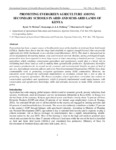| dc.description.abstract | Pastoralism has been a major source of livelihood for most of the families in Arid and Semi Arid Lands(ASALs). Studies have shown that the range land available to support enough livestock that can providesufficiently for ASAL livelihoods is on a decline trend (Mortimore, 2013). This land is characterized by severe degradation threatening human, crop and livestock survival. Besides, during prolonged drought, pastoralists have been reported to incur huge looses at times amounting to hundred percent. Evergreen agriculture which combines conservation agriculture and agroforestry would play a critical role in reclaiming back these lands as well as making them agriculturally productive. Agroforestry diversifiesand sustains production for increased social, economic and environmental benefits on plots of land of any size. Agricultural extension officers and a few Non-Governmental Organisations (NGOs) have done commendable work in promoting evergreen agriculture among ASAL communities. However, the education sector through the curriculum implementers in secondary schools has a role to play in promoting evergreen agriculture. The Kenya secondary school agriculture curriculum has content on conservation agriculture and agroforestry which if properly implemented would equip learners with conservation and agroforestry knowledge, skills and attitudes necessary to make ASAL schools ever green. | en_US |

